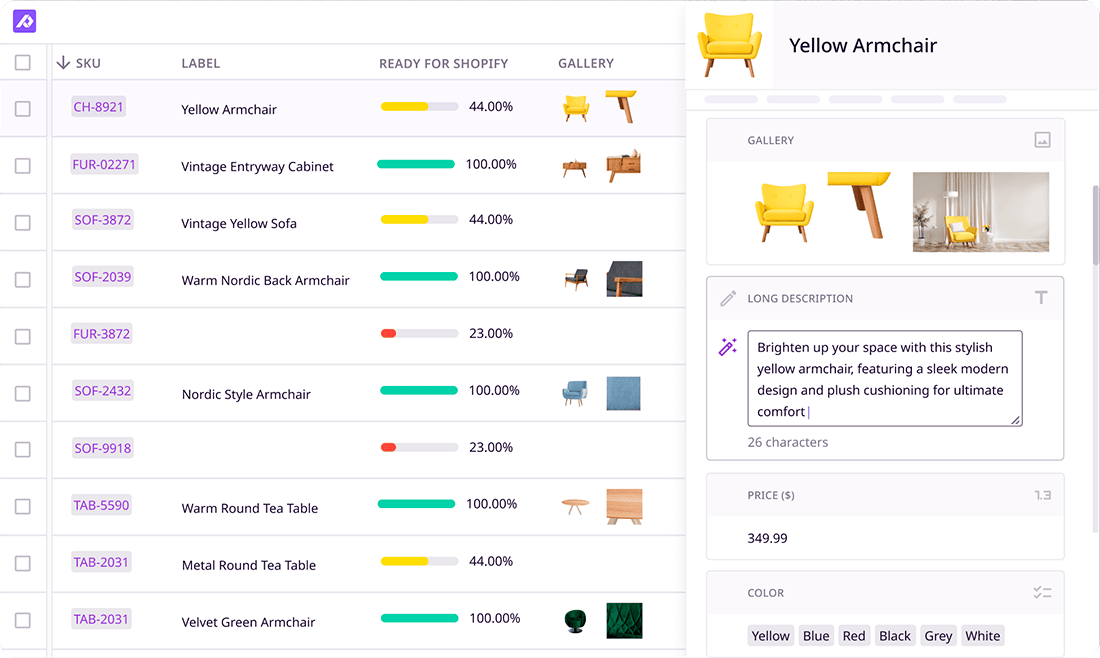Digital Product Passport: What You Need to Know About the DPP

Keep the good stuff coming
Subscribe to our blog newsletter and get monthly content that helps you manage product data smarter.
No spam. Just real value.
The European Commission is changing the way we sell physical products. Changes that won’t be fully implemented across all products and all industries until 2030, but changes that you’ll want to be ready for.
Want a quick overview before we dive in? Check out our video explanation!
Not a video person? No problem! Keep reading for all the details.
Keep in mind that the European Commission is still ironing out the details, so we’re going to take a look at everything there is to know about the digital product passport so far. You won’t leave this article knowing everything that’s going to happen because, let’s be honest, not even the European Commission has that information finalized.
So, let’s walk through the information about the digital product passport that we do know is available and finalized (from this European Commission session), and we’ll even take a look at what information is to come and when. That way, when the changes do come, you’ll be ready for a smooth transition no matter what.
What is a Digital Product Passport (DPP)?
A digital product passport (DPP) is a digital document that contains information about a product’s performance, sustainability, and circularity. It can be accessed through a QR code, NFC chip, or RFID tag.
Think of digital product passports as a digital "memory" for each product, detailing everything from the manufacturer, supply chain, and materials to characteristics, repair instructions, and disposal options. The goal is to make the entire lifecycle of a product transparent to all key stakeholders, including producers, retailers, and consumers. That way you’ll get the full picture of any given product you buy knowing not only the product's life story but also its environmental impact.

The DPP is a part of Ecodesign for Sustainable Products Regulation (a regulation coming from the Sustainable Product Initiative of the EU Green Deal) and is also recognized as a solution for the Circular Economy Action Plan. All of these are initiatives that help create a more sustainable and environmentally friendly world—starting with the products we buy. That’s why they need to create a standardized process that makes this information transparent and accessible.
Note: Digital product passports already exist and are in use by some companies. The important thing to note is that the European Commission is standardizing the process for everyone who sells physical products in the EU.
Key elements of the DPP
To help measure the environmental impact each product has, there are three types of information that all digital product passports will need to have:
- Performance: Details about a product’s functionality and efficiency
- Sustainability: Information on the environmental impact of the product
- Circularity: Insights into how the product can be reused, recycled, or disposed of responsibly
Keep in mind that the official standards still need to be set, so these areas will give you an idea of what to expect.
Performance: Setting high standards
Performance is an important aspect of the digital product passport requirements. The performance metrics of a product help show us the functionality and efficiency of a product. These metrics help in:
- Energy efficiency: Products are rated based on their energy consumption. For example, home appliances like refrigerators and washing machines can be compared based on their energy use, allowing consumers to make informed choices.
- Material use: Information on the types and quantities of materials used in the product. For instance, electronics might include details on the amount of rare earth elements, which are critical for understanding resource use and potential recycling challenges.
- Durability: Data on the expected lifespan of a product, which can guide consumers toward more durable options.

EU Energy labels for different types of electronics
Having information about a product’s performance available for everyone to see should motivate manufacturers to create high-quality products made to last. Not only is this going to be good for the environment but also for consumers who want to find quality products. Consumers will finally have an easy way to compare with data they can trust.
Sustainability: Reducing environmental impact
The sustainability aspect of the DPP focuses on minimizing the environmental footprint of products and keeping products environmentally sustainable. This includes:
- Carbon footprint: Information about the greenhouse gas emissions associated with the product throughout its lifecycle. For example, a digital passport for a smartphone might include data on emissions from manufacturing, transportation, usage, and disposal.
- Resource efficiency: Insights into how efficiently a product uses resources, including water, energy, and raw materials. This could be particularly relevant for industries like textiles, where water usage is a significant concern.
- Chemical safety: Details on hazardous substances present in the product, making sure that consumers are aware of any potential health risks.
By providing this information, the DPP helps promote sustainability, making it easier for consumers to make eco-friendly choices. This generally will help us reach the overall sustainability goals that the Ecodesign for Sustainable Products regulation set.
Circularity: Reusing, repairing, and recycling products
Circularity aims to extend the lifecycle of products through reuse, repair, and recycling. This aspect is what makes the digital product passport an important solution in the Circular Economy Action Plan (CEAP). Key circularity features include:
- Repairability: Information on how easy it is to repair a product, including the availability of spare parts and repair manuals. This is crucial for electronics, where repairability can significantly extend a product's lifespan.
- Recyclability: Data on the recyclability of materials used in the product. For instance, the DPP for a piece of furniture might include details on which parts can be recycled and how.
- End-of-life management: Guidelines for proper disposal of the product, making sure that valuable materials are recovered and waste is minimized.

The more we can limit waste and recycle what we have the better. This is the core of the CEAP. The European Commission is even pushing the concept of a Right to Repair, which is part of the broader initiative to make products more sustainable and reduce waste.
The Goal of the Digital Product Passport
The primary goal of the DPP is value retention. What do I mean by that? I mean keeping products and materials at the highest quality for the longest amount of time possible. And when they do reach the end of their lifecycle, they are remanufactured or recycled to the highest quality.
Another main goal of the DPP is to give (and simplify) access to relevant information. This information is normally held by the different businesses in the supply chain, but they haven’t had the incentive to share this information, making it difficult for everyone else to access it.
There are many other goals that the European Commission wants to accomplish with the DPP. Here are some other goals worth mentioning:
- Creating transparency
- Producing sustainable products
- Building a Circular Economy
- Reaching regulatory compliance
How does the Digital Product Passport work?
So, the DPP sounds good in theory, but how does it actually work? Well, you have to keep in mind that the European Commission still needs to define the DPP framework and processes, but we do have a good idea of how it should generally work.
To make this simple, let’s take a look at how it would work for a suitcase to have a digital product passport that checks all the DPP compliance boxes.

Seeing how the DPP works: The suitcase example
Data Collection
As the vendor of this gray suitcase, you will create a QR code (it could also be an NFC chip or RFID tag) that links to its main product identifier. But first, you’ll have to collect the right information to be compliant. As of today, we don’t know what that will be, but we know that each product group/industry has its own data requirements. So what works for batteries doesn’t mean that will be the same for suitcases.
We know for sure that we’ll have to provide these four identifiers:
- Product identifier
- Economic operator identifier
- Facility identifier
- Registration identifier (not public)
We also know that based on the key elements (performance, sustainability, and circularity), you’ll need to provide information about the supply chain, the materials used, the product lifecycle, and so on. You’ll need to collect that data from your supply chain partners. We recommend you use a tool like Product Information Management (PIM) software for your product data to save you time. You’ll need a solid product database to help store and work on all of this information across your product catalog.
Note: The DPP is technologically neutral, so you can use whatever technology suits you best.
Like I mentioned before, the European Commission still needs to create the specific standards for each product group, but here are some examples of the type of data you might see in a digital product passport in the image below.

Information access
Once you have all your data ready for the DPP, you can have your QR code embedded into your suitcase’s tag. That way your supply chain partners, regulators, and customers will be able to scan your QR code to get whatever information they need about the suitcase. They’ll be able to get the full picture of how sustainable the suitcase is and how to repair, reuse, or recycle it.
This information will help them to make educated decisions on what they want to buy. Because other suitcases will have a DPP, customers will be able to compare the information between each suitcase option. And who knows, this might just be your competitive advantage if you’re able to prove that your suitcases are more environmentally friendly than others.
Updates and backups
Your suitcase’s lifecycle information is going to be continually updated throughout its lifecycle. This keeps the information about maintenance, repairs, and disposal transparent and accurate. You’ll also need to provide backup data about your suitcase. That way the data lasts all the way through the suitcase’s lifecycle, regardless of what happens to your company.
Who does the Digital Product Passport impact?
Primarily, digital product passports impact countries within the European Union, considering that this is where the regulations are being created and enforced. The DPP regulations will also impact anyone from outside the EU who sells products to the European market because they will also have to comply with regulations.
This might also spark other countries to implement similar regulations, so there might be a bigger impact along the way. Only time will tell—depending on the success of this initiative, of course.
When will the DPP be up and running?
Digital product passports are estimated to be fully up and running across all industries by 2030. While the full timeline is unclear, we do have some dates that the European Commission has given. We can expect:
- Nothing will officially be enforced before July 19, 2025.
- The destruction of unsold consumer products will be prohibited as of July 19, 2025.
- The European Commission will have a definition of standards no later than December 2025.
- Digital battery passports will be mandatory for specific types of batteries by 2027.
- Digital product passports will be fully implemented for every product sold in the EU by 2030.
- On July 19, 2030, the European Commission will evaluate the effectiveness of the DPP (and will do so every 6 years).

The first industries that will be required to use digital product passports are these ones here:
- Batteries
- Traction batteries
- Light transport batteries
- Industrial batteries (with a capacity of more than 2 kw/h)
- Iron
- Steel
- Aluminum
- Textiles (including clothing and footwear)
- Furniture (including mattresses)
- Tires
- Detergents
- Paints
- Lubricants
- Chemicals
- ICT products
- Electronics
These sectors are targeted because they’ll have a high impact on the EU's climate, environmental, and energy objectives. The official dates for these specific sectors are to be determined, but they will be the first ones that’ll need to get their digital product passports in order.
Embracing the change
These changes may not feel like great news because they add new layers of work on top of everything else you have to do. But these changes need to happen so that we can create transparency around the environmental impact of our products.
As I said before, the DPP can even give you a competitive advantage. If you’re a company that has invested in selling sustainable and ethical products, you’ll be able to stand out from the rest who don’t. Sustainability attracts customers, and customers will now be able to see that.
If we look at the heart of the DPP, it’s much more than data collection or meeting an implementation deadline. It’s about creating transparency around what we buy and how we can make this world more sustainable. And by embracing the DPP, you’re doing your part to get us there.
Frequently asked questions
The EU digital product passport regulation mandates that products sold within the EU have a digital record detailing their lifecycle, from raw materials to disposal, to enhance transparency, sustainability, and circularity.
DPP in sustainability refers to the Digital Product Passport, which provides detailed information about a product's environmental impact, materials, and lifecycle, promoting sustainable production and consumption.
The digital product passport for clothing offers comprehensive information on a garment’s materials, manufacturing processes, sustainability credentials, care instructions, and end-of-life disposal options.
The EU digital product passport for textiles is a regulatory requirement that makes sure textiles have a digital record detailing their composition, production, sustainability impact, and recycling options—promoting transparency and circularity in the textile industry.

Bergen Palmer
Bergen Palmer is a content marketer at Plytix, where she writes all about product information and ecommerce. With a background in ecommerce SaaS and content strategy, she focuses on creating clear, trustworthy content that helps brands work better with their product data.

What if your product data actually worked for you?
We’ll show you how Plytix helps you stop fixing data—and start using it.
Related posts
Keep the good stuff coming
Subscribe to our blog newsletter and get monthly content that helps you manage product data smarter.
No spam. Just real value.




Think others should see this?
Go ahead and share it.